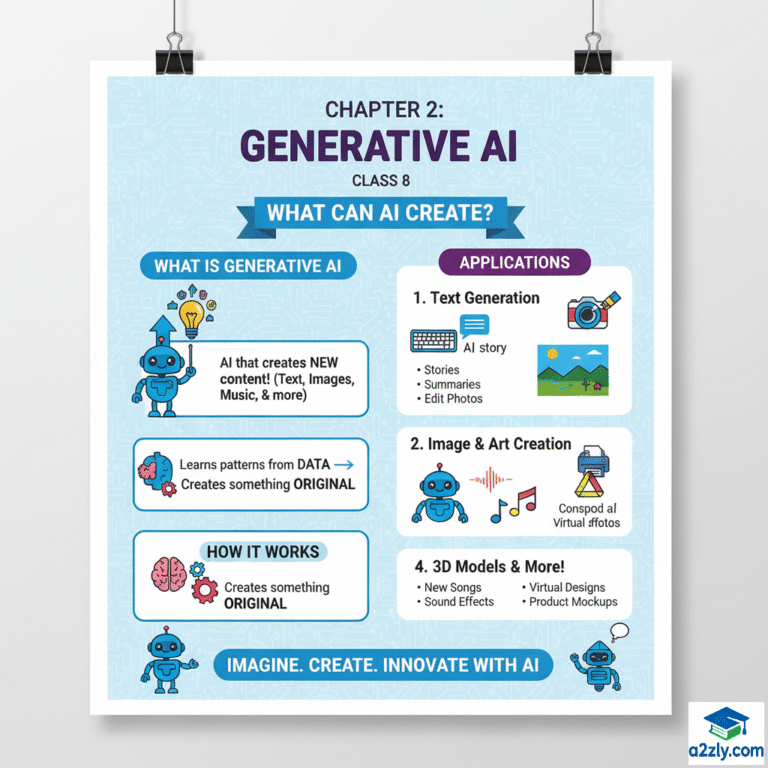🧠 Chapter Overview
Generative AI is one of the most fascinating fields of Artificial Intelligence.
It not only analyzes existing data but also creates new content — such as text, images, music, and videos — just like humans!
2.1 Introduction to Generative AI
💡 Definition:
Generative Artificial Intelligence (Generative AI) is a branch of AI that can create new and original content such as text, images, videos, sounds, or code by learning patterns from existing data.
It doesn’t just recognize or classify — it generates something new.
🧩 Examples:
| Tool / Platform | What It Generates |
|---|---|
| ChatGPT | Text, essays, code, ideas |
| DALL·E / Midjourney | Images and art |
| Synthesia / DeepFake | Videos |
| Jukebox / Suno AI | Music and audio |
| Copilot / CodeWhisperer | Computer code |
📖 Simple Explanation:
If traditional AI answers your questions,
Generative AI writes new answers, stories, or even poems — it creates.
🧠 Mind Map: Introduction to Generative AI
GENERATIVE AI
|
--------------------------------
| | |
Creates Text Creates Images Creates Audio/Video
| | |
ChatGPT DALL·E DeepFake
2.1.1 Difference Between AI and Generative AI
| Basis | Artificial Intelligence | Generative AI |
|---|---|---|
| Definition | Simulates human intelligence to perform tasks | Creates new content using learned data |
| Function | Analysis, prediction, classification | Generation of new data (text, image, etc.) |
| Example | Spam filter, recommendation engine | ChatGPT, DALL·E, Gemini |
| Input–Output | Input → Output | Input → New creative Output |
| Data Use | Uses existing data for decision-making | Uses existing data to produce new data |
🧠 Example Comparison:
| Situation | Traditional AI | Generative AI |
|---|---|---|
| You ask for a movie recommendation | Suggests movies you might like | Writes a new story or script for a movie |
2.1.2 How Generative AI Creates New Content
Generative AI works by learning patterns, relationships, and structures from massive amounts of data and then using this knowledge to generate new, similar data.
⚙️ Steps in Generative AI Process:
| Step | Description |
|---|---|
| 1. Data Training | The AI is trained on large datasets (text, images, etc.) |
| 2. Pattern Learning | It learns relationships, grammar, and context. |
| 3. Generation | When given a prompt, it predicts what should come next. |
| 4. Refinement | The model improves outputs using feedback and examples. |
🧬 Common Generative AI Techniques:
- Neural Networks – The brain of AI systems that mimic human neurons.
- Transformers – Advanced architecture used in ChatGPT, BERT, Gemini.
- Diffusion Models – Used in image generators like DALL·E and Midjourney.
💬 Example:
When you tell ChatGPT —
“Write a poem about the sun,”
it analyzes language patterns from millions of texts and creates a new poem that never existed before.
🧠 Mind Map: How Generative AI Works
How Generative AI Creates New Content
|
--------------------------
| | | |
Data Pattern Generation Feedback
Training Learning Process Loop
2.2 Types of Generative AI Models
Generative AI models can be categorized based on how they generate content.
| Type of Model | Full Form | Function | Example |
|---|---|---|---|
| GAN | Generative Adversarial Network | Creates realistic images/videos by having two models (Generator & Discriminator) compete | DeepFake, StyleGAN |
| VAE | Variational Autoencoder | Learns data compression and generates new samples similar to original data | Image & audio synthesis |
| Transformer Models | — | Uses attention mechanism to generate language and content | ChatGPT, BERT, Gemini |
| Diffusion Models | — | Gradually converts random noise into clear images | DALL·E, Midjourney, Stable Diffusion |
| LSTM Models | Long Short-Term Memory | Generates text or sequences based on memory of previous words | Text generation, music creation |
🧠 Mind Map: Types of Generative AI Models
Types of Generative AI Models
|
----------------------------------------
| | | | |
GAN VAE Transformer Diffusion LSTM
2.3 Applications of Generative AI
Generative AI is transforming almost every field of technology, education, and creativity.
| Field | Application Example |
|---|---|
| 🧠 Education | Personalized learning content, AI tutors, question generation |
| 🎨 Art & Design | AI image generation, creative artwork, fashion design |
| 💼 Business | Automated report writing, chatbots, customer service |
| 🎬 Entertainment | Script writing, video generation, background music |
| 🧬 Healthcare | Drug discovery, medical image synthesis, diagnostics |
| 💻 Coding | AI code assistants like Copilot and ChatGPT Code Interpreter |
| 🌐 Social Media | Filter creation, content moderation, caption generation |
📍 Example Scenarios:
- Student use: Writing essays, summarizing notes.
- Artist use: Creating digital paintings in seconds.
- Teacher use: Generating quizzes and question papers.
🧠 Mind Map: Applications of Generative AI
Applications of Generative AI
|
------------------------------------------------
| | | | |
Education Business Art/Design Healthcare Entertainment
2.4 Advantages of Generative AI
| Advantage | Description |
|---|---|
| ⚡ Creativity Boost | Helps in generating ideas, art, and designs faster. |
| 🕒 Saves Time | Automates writing, coding, and design tasks. |
| 🎯 Personalization | Adapts learning or content to user preferences. |
| 💰 Cost Efficiency | Reduces the need for manual creative work. |
| 🧠 Innovation | Encourages new discoveries in science and art. |
🧠 Mind Map: Advantages of Generative AI
Advantages of Generative AI
|
----------------------------
| | | |
Creativity Speed Personalization Innovation
2.5 Ethical Concerns of Generative AI
While Generative AI is powerful, it also raises serious ethical and social issues.
| Ethical Issue | Description | Example |
|---|---|---|
| ⚠️ Misuse / Deepfakes | Fake videos or images that mislead people | Political deepfakes |
| 🧾 Plagiarism | AI copying content without credit | AI-written essays |
| 💬 Misinformation | Creation of fake news | AI-generated fake news articles |
| 🧠 Bias | AI reflecting human or dataset bias | Stereotypes in AI art |
| 🔒 Privacy | Use of personal data in training models | Voice cloning without consent |
| 💼 Job Loss | Automation of creative jobs | Artists, writers replaced by AI |
⚖️ How to Handle Ethical Concerns
- Always verify AI-generated content.
- Use AI responsibly and ethically.
- Ensure transparency (mention when content is AI-made).
- Government and organizations must create AI usage guidelines.
🧠 Mind Map: Ethical Concerns
Ethical Concerns of Generative AI
|
----------------------------------------
| | | | |
Deepfakes Bias Misinformation Privacy Job Loss
2.6 Future of Generative AI
Generative AI will continue to grow, becoming more accurate, creative, and human-like.
🔮 Predicted Future Trends:
| Area | Future Development |
|---|---|
| 🧠 Education | AI tutors that can talk, explain, and evaluate students. |
| 🎨 Art & Media | Real-time video generation and 3D world creation. |
| 💬 Communication | Personalized AI assistants for everyone. |
| 🧬 Science | Faster discovery of new materials and medicines. |
| 💼 Employment | New AI-related careers (AI Ethics, AI Design, Prompt Engineering). |
🧠 Key Vision:
Generative AI + Human Creativity = Co-Creation Future
Humans and AI will collaborate, not compete.
🧭 Mind Map: Future of Generative AI
Future of Generative AI
|
-------------------------------------
| | | | |
Education Art/Media Science Business Ethics
📘 Summary Table: Generative AI
| Section | Key Idea | Example |
|---|---|---|
| 2.1 | Generative AI Introduction | ChatGPT, DALL·E |
| 2.1.1 | AI vs Generative AI | Predicts vs Creates |
| 2.1.2 | How It Works | Uses data patterns to generate new content |
| 2.2 | Types of Models | GAN, VAE, Transformer, Diffusion |
| 2.3 | Applications | Education, Art, Coding, Healthcare |
| 2.4 | Advantages | Creative, Efficient, Personalized |
| 2.5 | Ethical Concerns | Bias, Deepfakes, Privacy issues |
| 2.6 | Future | Human-AI collaboration and innovation |
✅ Key Takeaways
- Generative AI creates new data — not just analyzes it.
- It’s used in text, image, video, and audio generation.
- Popular models include GANs, Transformers, Diffusion Models.
- While it offers creativity and efficiency, it also raises ethical issues like bias and misinformation.
- The future of AI lies in collaboration between humans and machines.

